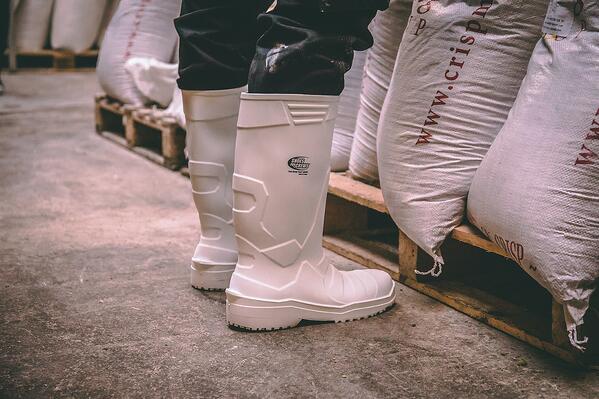In the bustling environment of the meat processing industry, the right footwear is not just about comfort—it’s a vital part of personal protective equipment (PPE).
White butcher boots are more than just a uniform requirement. They are a critical safety feature for any professional in this field.
Some Background and Context
The adoption of boots in these environments aligns with the global progression towards improved worker safety and hygiene standards, which gained significant momentum in the 20th century.
In South Africa, as in many other countries, the introduction of boots in slaughterhouses and abattoirs would have been influenced by industrial safety regulations and the recognition of the need to protect workers from the various hazards in meat processing facilities.
This includes the risk of slips, falls, and cuts and the need to prevent contamination and ensure food safety. White boots, specifically in these settings, are also tied to the industry’s emphasis on cleanliness and the ability to easily notice contamination.
Safety First
The use of white boots in Personal Protective Equipment (PPE) within the South African meat processing industry is a testament to the sector’s commitment to safety, hygiene, and regulatory compliance. These boots serve as a critical barrier between the workers and the daily occupational hazards, including sharp tools, heavy machinery, and slippery floors.
Why White?
The white boot is not just a matter of uniformity but a strategic choice for its visibility, which aids in detecting contamination promptly, ensuring that hygiene standards are upheld.
Moreover, white boots symbolise the industry’s dedication to maintaining a clean and sterile environment, which is essential in processing meat products. They are designed to be easily sanitised, reducing the risk of cross-contamination and ensuring the safety of the food supply chain.
The importance of such PPE is underscored by the stringent health and safety regulations that govern the meat processing industry, which demand that all personnel are adequately equipped to mitigate risks.
- White Boot PPE: These boots are designed to meet the rigorous safety standards required in meat processing, providing protection and contributing to the facility’s overall hygiene.
- White Butcher Boots: Specifically tailored for the needs of butchers, these boots offer slip resistance, durability, and easy cleaning—qualities essential for the demanding conditions of meat processing
- White Boots for Butchers: Emphasising practicality and safety, white boots for butchers are an industry standard, ensuring workers can perform their tasks without worrying about slips or falls.
- White Butcher Boots for Sale: Available for purchase through various suppliers, these boots can be easily found to suit different needs and preferences, ensuring every butcher has access to high-quality protective footwear.
- White Butcher Boots Near Me: For those looking to buy locally, many retailers stock white butcher boots, making it convenient to find the right pair for your safety and comfort needs.
The Necessity for PPE Within the Industry
White butcher boots symbolise the commitment to safety and hygiene in the South African meat processing industry. They provide the necessary protection against workplace hazards while supporting the stringent health standards required in food processing.
Boots are a fundamental element of Personal Protective Equipment (PPE) in slaughterhouses and abattoirs for several reasons:
- Protection from Hazards: The meat processing environment is filled with potential hazards such as sharp objects, heavy machinery, and slippery floors. Boots provide essential protection against cuts, punctures, and falls.
- Hygiene and Sanitation: Boots help maintain workplace hygiene by preventing contaminants’ spread. They are easy to clean and disinfect, which is crucial in environments where meat is processed.
- Compliance with Safety Standards: Wearing appropriate footwear is often a regulatory requirement to ensure the safety of workers in the meat industry. Boots that are specifically designed for slaughterhouses meet these safety standards.
- Prevention of Cross-Contamination: Properly designed boots can prevent transferring bacteria and pathogens from the floor to the meat, ensuring food safety and quality.
- Comfort and Support: Given the long hours workers spend on their feet, boots also provide comfort and support, which is important for worker welfare and productivity.
In the broader context of South African labour practices, white boots in PPE also reflect the country’s progress in worker welfare. They are a physical representation of the measures taken to protect employees, demonstrating the value placed on their well-being and recognising their rights to a safe workplace. The ongoing use of white boots in PPE underscores a culture of safety that is integral to the meat processing industry’s operations.
Invest in Quality White Bucher Boots PPE
The role of white boots in PPE within South Africa’s meat processing industry is multifaceted. They are a practical tool for protection and a symbol of the industry’s adherence to high standards of safety, cleanliness, and worker respect. As the industry continues to evolve, white boots will undoubtedly remain a cornerstone of its safety protocols, reflecting an unwavering commitment to quality and care in every step of meat processing.





